Lovely for Easter, May Day, or Mother's Day, these baskets are made from contoured cookie dough covered with frosting sheets. Simply swap out what's tucked inside to adapt them to a particular holiday!

What you’ll need for one basket:
- Cookie dough of your choice
- 1 small tin can, label removed (For the baskets pictured above, I used a 3 1/4-inch diameter can, about 2 inches deep, with both lid and bottom removed, though removing these parts is optional for this project. To change the basket size, simply change the size of the can.)
- A round cookie cutter, to hold the other can upright during baking
- Large (about 4 1/4-inch) fluted round cookie cutter
- Cookie sheet, lined with a silicone baking mat (latter, optional)
- Paring knife
- Microplane grater or clean file
- About 1 cup Royal Icing for topcoating, "glue," and detailing
- Assorted soft-gel (aka liqua-gel) food coloring
- Parchment paper pastry cones (or substitute disposable plastic piping bags or pastry bags fitted with round tips)
- 1 to 2 (8 x 10-inch) pre-printed and/or plain frosting sheets
- A few tablespoons light corn syrup
- Small sponge brush
- A fondant handle or two (see details in Step 3, below)
- Enough sanding sugar to fill the basket
- Assorted small candies or cookies to fill the basket
To make:
1 | Bake your basket pieces. Choose your favorite cookie dough. Generally one that does not spread much is better for this project, as the dough will be less likely to crack or break while baking on the tin can. I find that my gingerbread cookie dough works slightly better than my sugar cookie recipe, though reducing the leavening in the latter makes it hold its shape better.
Place the "support" cookie cutter on a cookie sheet, ideally lined with a silicone baking mat so the cutter will not slide. Then place the tin can (which will be used to shape the cookie dough) on its side in the support cutter. The support cutter should be selected so that the tin can will stay standing up when the cookie sheet is moved.
Cut a strip of dough long enough to wrap slightly more than halfway around the tin can; then carefully drape it over the side of the can (see second and third photos in the attachments, below). Bake at the usual temperature for your dough, however, watch the strip carefully while it bakes. If it begins to over-expand and start cracking, trim off any excess dough on either end of the strip to the halfway mark on the can. This excess, over-expanded dough can "pull" on the strip and cause it to crack. Pull the cookie sheet out of the oven once the strip is baked, and allow the strip to cool slightly before gently popping it off the can. Repeat to create another half-ring, which will become the other half of your basket.
Also, cut out and bake a large fluted cookie round (with diameter larger than that of the can) to form the basket base. For more tips on contouring cookie dough, please check out my other tutorial here.
2 | Prep the basket pieces for assembly. Despite any trimming done during baking, the two halves of your basket are unlikely to fit neatly and flush together (see photos four through six, below). But any ill-fitting pieces are easy to remedy with a handy microplane grater. Simply file down the edges until the two pieces fit nicely together. Don't worry about the seams; they'll be covered with frosting sheets in Step 4.
3 | Decorate the basket base and make the handle (if you haven't already). If desired, portion off a small amount of icing, thin it to topcoating consistency, and use it to smoothly ice the top of your cookie base. Allow the base icing to dry completely before further assembly in the next step.
In the meantime, make a fondant handle by rolling a small amount of fondant into a thin sheet (I use a hand-cranked pasta machine for this task) and then cutting a thin (about 1/8-inch-wide) strip from that sheet. Bend the strip into an arc (handle shape) on the back side of a lined cookie sheet and allow the handle to air-dry until it is completely set and rigid (i.e., it can be picked up without misshaping). For a handle as delicate as those shown here, drying time can be a few hours, but I usually allow overnight or accelerate the drying (to about 30 minutes) in my dehydrator set at its lowest temperature (95°F). You may also want to make a few extras for backup. Once fondant dries, it gets extremely brittle and can easily break if you're not used to handling it.
4 | Start basket assembly and wrap the basket sides with frosting sheets. Once the cookie base has dried, set the two half-cookie rings on top so they form a perfect circle and glue them on the base and to each other with thick royal icing. I usually tint the icing the color of the dough (in this case, brown) so the "glue" is less likely to show. Allow the icing "glue" to set for a bit, maybe 20 to 30 minutes, or just until the ring will not move on the base when gently pushed.
Cut out a single strip of frosting sheet that is long and tall enough to completely cover the sides of the ring you just glued together. Be sure to use frosting sheets and not wafer paper, as wafer paper will not stick well to un-iced cookies. Also, be sure to choose frosting sheets that are very opaque; otherwise, once they're applied, you'll be able to see through to the cookie. (In this case, my pre-printed sheets were pretty sheer, so I backed them with thicker plain frosting sheets so they would not be see-through.)
To stick the frosting sheet on the cookie ring (or to back it with another frosting sheet), simply schmear a very small amount of light corn syrup on the back of the paper using a clean sponge brush. The entire surface should be tacky, but not wet. Then, before the corn syrup dries, wrap the tacky side of the paper around the basket, orienting the seam on the side of the basket that you think is least attractive (i.e., what will become the back)! See photo seven for how the basket should look at this stage!
5 | Detail the basket pieces and finish assembly. Use any remaining icing to detail the edges of the basket ring or base, or to add interest to the handle. Of course, since I love dots so much, I used them generously! (You can find more tips for dots, aka beadwork, here.) Once the details are dry, you're ready to move onto final assembly!
You can "glue" the handle into the basket with thick royal icing, and then again allow some time for the icing to set the handle in place. But, to save time, I often fill the basket with sanding sugar and then carefully plunge the handle into the sugar so it stands straight up. Feel free to fill the basket with cookies or candies, or something else to suit whatever holiday! I used flower and leaf cookies, which were mounted to flat wooden sticks with thick icing. If the icing is thick enough, you can also "hang" lightweight cookies, like the butterflies shown below, on the edge of the basket without need for much propping. Malted eggs are also great filler!
Oh, and if you were wondering, here's where I got the frosting sheets used here:
- Patterned sheets: Designer Prints Edible Images (also sold elsewhere online)
- Thicker plain white "backing" sheets: Kopykake
Any questions? Just give me a shout-out here or on my site, link below.



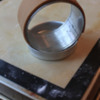
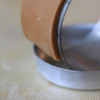
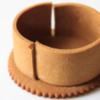

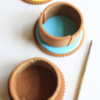
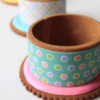
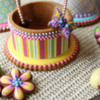
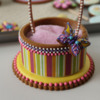

Comments (15)